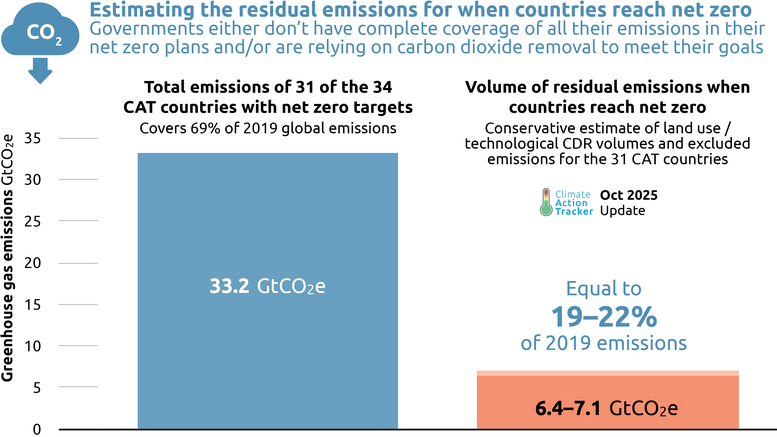CAT net zero target evaluations
Content
- Urgent need for nuanced and transparent assessments of national net zero targets
- CAT's ten-step net zero target evaluation methodology
- Country evaluations as of October 2025
- Residual emissions in net-zero target years up to a fifth of current emissions
- In-depth net zero evaluation by country
- Featured work
- References
Urgent need for nuanced and transparent assessments of national net zero targets
Last updated 27.10.2025
As of October 2025, around 145 countries had announced or are considering net zero targets, including China, the EU, and India. The countries cover close to 77% of global emissions (Figure 1). After the Biden Administration committed to a net zero target by 2050 as part of the US long-term strategy submitted to the UNFCCC in 2021, the Trump Administration reversed course and no longer commits to reaching net zero emissions. Therefore, the CAT considers the US to no longer have a net zero target, even though 19 states are still pursuing net zero (Net Zero Tracker, 2025).
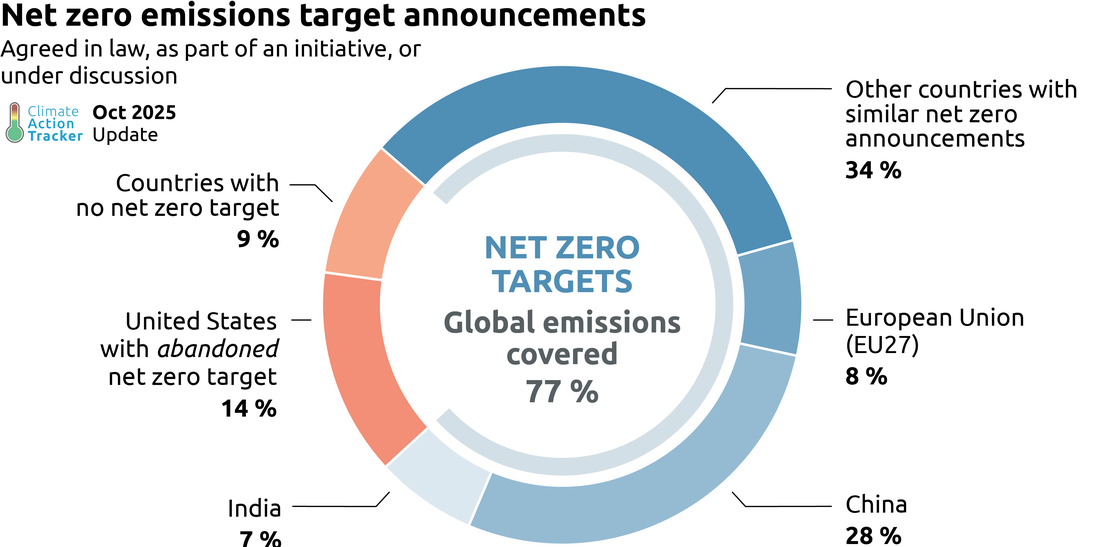
Figure 1: Share of global GHG emissions covered by national net zero emission targets (agreed in law, as part of an initiative, or under discussion). Compilation based on data from the Net Zero Tracker (2025) and Climate Watch (2025) as of 29 September 2025 and complemented by CAT analysis. The compilation includes countries that have joined the Climate Ambition Alliance announced at COP25 (Climate Ambition Alliance, 2019). Emissions data excluding LULUCF for 2019 taken from PRIMAP emissions database (Gütschow, Busch and Pflüger, 2025).
At their best, well-designed and ambitious net zero targets are key for reducing global carbon dioxide and other greenhouse gas emissions to net zero around 2050 and 2070, respectively. This is necessary to keep warming to the Paris Agreement’s 1.5°C limit. Ambitious net zero targets can also guide the implementation of Paris-aligned actions in the short and medium term, in particular 2030 - and newly-submitted 2035 - emission reduction goals.
At their worst, net zero targets are unclear or not backed up by real-world action. Net zero targets can distract from the urgent need for deep emission reductions if NDCs and short-term action are inconsistent with their achievement, allowing governments to “hide” behind aspirational net zero targets. Unless governments start acting now, their chances of achieving net zero will be slim.
There is a clear need for a nuanced assessment of incoming national net zero targets to understand their scope, architecture, and transparency. Without such scrutiny, there is a risk that poorly backed up net zero claims could render these targets meaningless.
CAT's ten-step net zero target evaluation methodology
The CAT (2021) has identified ten key elements of each country’s net zero target to assess whether the scope, architecture, and transparency meet what we define as good practice (see Figure 2). Our evaluation method remains exclusively applicable to net zero targets by national governments and cannot be directly applied to other subnational or non-state actors (especially corporations).
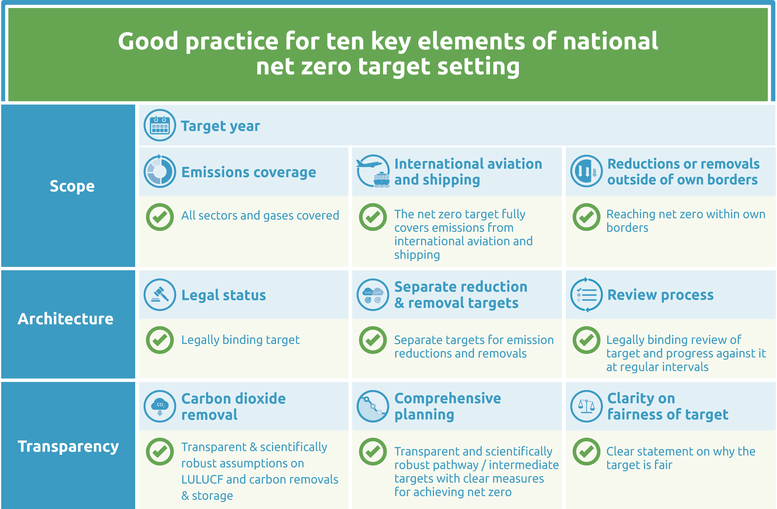
Figure 2: Identified good practice for all ten key elements in the Climate Action Tracker’s evaluation methodology for countries’ net zero targets.
Country evaluations as of October 2025
Our net zero evaluations for G20 countries and selected other countries as of October 2025 show that most net zero targets are formulated vaguely and do not yet conform with good practice across different design elements. Robust short-term targets and pathways towards achieving them will be required to fully realise their ambition.
These evaluations aim to provide a nuanced assessment of national net zero targets to understand their scope, architecture, and transparency. Without such scrutiny, there is a risk that poorly backed up net zero claims could render these targets meaningless.
Table 1: Overview of Climate Action Tracker’s net zero target evaluations for G20 member countries (excluding France and Italy as both not separately analysed by the CAT) and selected other countries per key elements as of October 2025
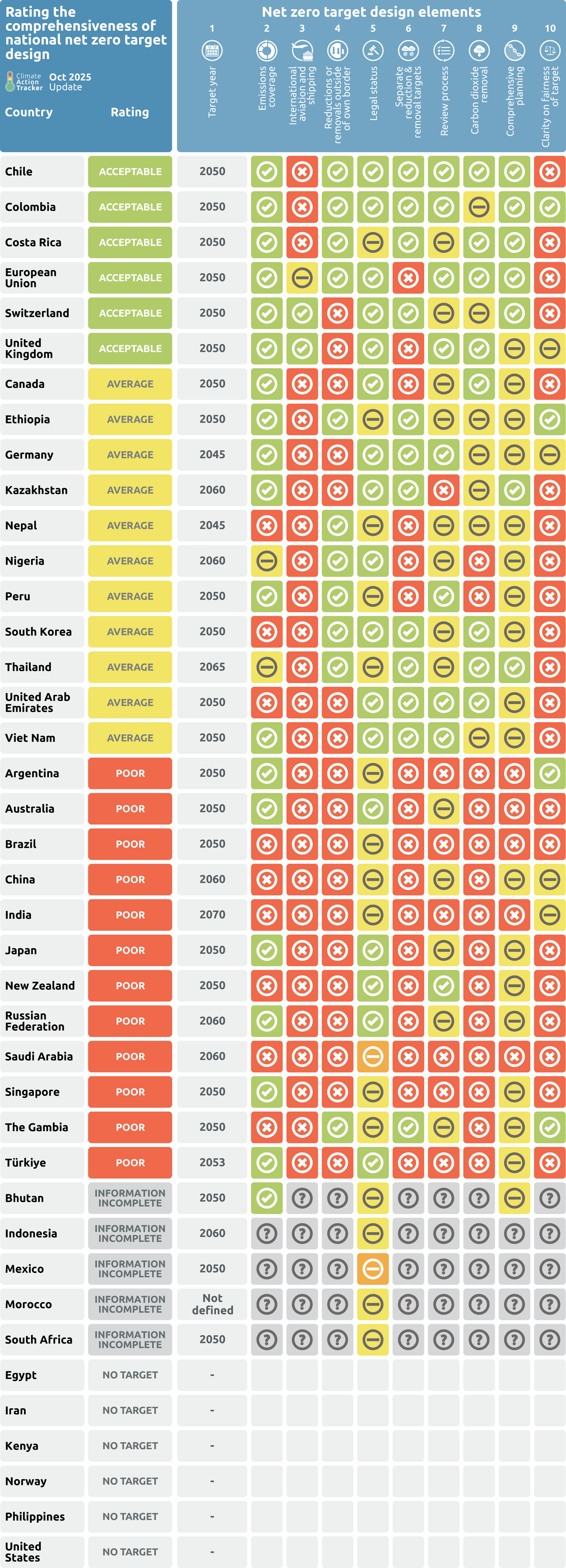
Governments need to improve their net zero target design. According to the CAT’s “good practice” net zero analysis, the design of net zero targets covering a total of 63% of global emissions remains insufficient (Figure 3).
Only six of the 41 countries currently assessed by the CAT, responsible for 8% of global GHG emissions, have defined their net zero targets in a manner the CAT rates as ‘acceptable’ in terms of scope, architecture, and transparency.
Another 11 countries, responsible for 9% of global emissions, fall into the ‘average’ category. We are a long way from converting net zero targets into policies and actions that will result in real-world emissions reductions.
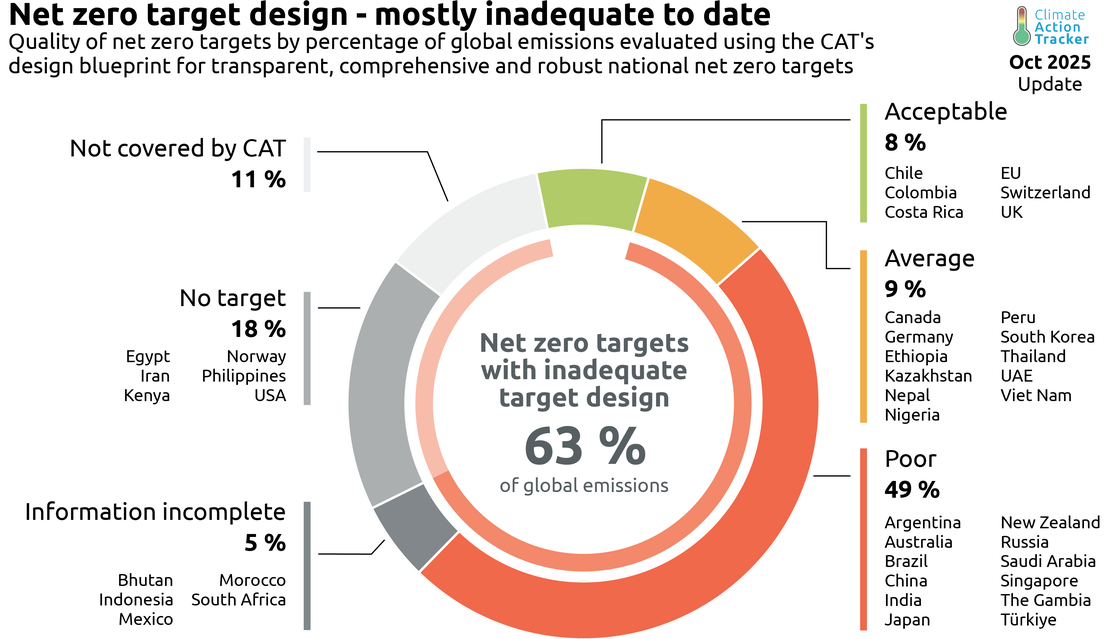
Figure 3: Share of global GHG emissions by Climate Action Tracker’s headline evaluation for announced net zero targets as of October 2025. Emissions data excluding LULUCF for 2019 taken from PRIMAP emissions database (Gütschow, Busch and Pflüger, 2025).
Residual emissions in net-zero target years up to a fifth of current emissions
Emission scenarios compatible with the 1.5°C Paris Agreement temperature limit are clear: in addition to achieving deep cuts in emissions across all sectors of the global economy, global emissions need to become net negative as soon as possible. This mandates the accelerated scale-up of carbon dioxide removal (CDR) globally (Geden et al., 2023; Smith et al., 2023). The reliance on CDR to limit global warming to 1.5°C, however, must be kept as low as possible, acknowledging the tremendous uncertainties around reliability, costs, and permanence.
The latest research defines CDR as “capturing CO2 from the atmosphere and storing it away for decades to millennia” (Smith et al., 2023, p. 11). Removal options at this stage are either reversible (e.g., forestry sinks) or expensive and technologically unmature (e.g., direct air capture and storage). While strong policy support will be required to accelerate CDR deployment overtime, governments might opt to prioritise an overreliance on potentially available CDR instead of effectively reducing their own emissions.
Detailed information on governments’ plans to rely on CDR remains scarce. Among the 34 countries assessed by the Climate Action Tracker that have pledged net zero, 21 countries provide more detailed information on LULUCF sinks and/or engineered CDR and storage in their net zero target year.
Most governments plan to heavily rely on carbon dioxide removal or leave out a share of their emissions from the target. We conservatively estimate this to be almost a fifth of their current emissions. For this estimation, we have taken a closer look at 31 of the 34 governments with net zero targets1 which jointly cover 69% of global 2019 emissions.
Even under conservative estimates, residual emissions in the countries’ net-zero target years will amount to 19–22% of total 2019 emissions based on the latest available information (see Figure 4, conservative estimate). Countries like Australia, Chile, New Zealand, Russia, Saudia Arabia and Viet Nam would still emit more than 30% of their 2019 emissions even after meeting their “net zero target”.
Figure 4: Conservative estimates of total remaining emissions in respective net-zero target years by 31 countries that cover 69% of 2019 global emissions. Estimates based on information and data tracked by the Climate Action Tracker (CAT) as of October 2025.
Governments are heavily relying on forestry sinks (referred to as land use, land-use change and forestry, or LULUCF) to balance remaining emissions. As of October 2025, we estimate that the same 31 governments mentioned above jointly assume LULUCF sinks of 4.6–5.5 GtCO2e, representing 14–17% of their 2019 emissions.
Forestry sinks face issues of both permanence and scarcity:
- On permanence, climate change and direct human interferences lead to uncertainty on the performance of stored carbon in forests and other ecosystems (Geden et al., 2023).
- On scarcity, the Land Gap Report found that countries’ climate pledges, including NDCs and LTSs, would require around one billion hectares of land prioritised for CDR (Self et al., 2023), more than the combined areas of South Africa, India, Türkiye and the European Union.
These plans critically exceed the potential for global sustainable potential for nature-based CDR.
Only seven governments2 currently communicate some information on engineered CDR underpinning their net-zero targets. Their plans jointly amount to 0.2–0.5 GtCO2e, representing 4–8% of their 2019 emissions. These results for LULUCF sinks and engineered CDR are in line with other recently published literature in the field for different country samples (Smith, Vaughan and Forster, 2022; Buck et al., 2023; NewClimate Institute & CEEW, 2023).
As carbon removals face uncertainties on permanence, sustainability and availability at this stage and may not happen at the pace, scale and costs as currently planned for, governments should focus their attention on reducing their own emission to real zero while at the same time accelerating CDR to achieve net negative emissions in the second half of this century.
Several governments transparently communicate their plans to rely on LULUCF sinks and/or engineered CDR underpinning their net-zero targets, among them are Chile, Costa Rica, and South Korea. Alongside the need for transparency, countries should aim for a minimum reliance on LULUCF sinks and engineered CDR to meet their net-zero targets and underpin their targets with deep cuts in emissions across all sectors of the global economy.
1 Argentina, Australia, Brazil, Canada, Chile, China, Colombia, Costa Rica, Ethiopia, European Union, Germany (analysed separately but not aggregated as included in EU), India, Indonesia, Japan, Kazakhstan, Mexico, Nepal, New Zealand, Nigeria, Peru, South Korea, Russia, Saudi Arabia, Singapore, South Africa, Switzerland, Thailand, Türkiye, UAE, UK, and Viet Nam.
2 Australia, Canada, EU, South Korea, Switzerland, UAE, and the UK.
In-depth net zero evaluation by country
The in-depth evaluation for all net zero targets on scope, target architecture, and transparency are available on the country assessment pages.
 Argentina - Net zero evaluation
Argentina - Net zero evaluation
 Australia - Net zero evaluation
Australia - Net zero evaluation
 Bhutan - Net zero evaluation
Bhutan - Net zero evaluation
 Brazil - Net zero evaluation
Brazil - Net zero evaluation
 Canada - Net zero evaluation
Canada - Net zero evaluation
 Chile - Net zero evaluation
Chile - Net zero evaluation
 China - Net zero evaluation
China - Net zero evaluation
 Colombia - Net zero evaluation
Colombia - Net zero evaluation
 Costa Rica - Net zero evaluation
Costa Rica - Net zero evaluation
 Ethiopia - Net zero evaluation
Ethiopia - Net zero evaluation
 European Union (27) - Net zero evaluation
European Union (27) - Net zero evaluation
 Gabon - Net zero evaluation
Gabon - Net zero evaluation
 Germany - Net zero evaluation
Germany - Net zero evaluation
 India - Net zero evaluation
India - Net zero evaluation
 Indonesia - Net zero evaluation
Indonesia - Net zero evaluation
 Iran - Net zero evaluation
Iran - Net zero evaluation
 Japan - Net zero evaluation
Japan - Net zero evaluation
 Kazakhstan - Net zero evaluation
Kazakhstan - Net zero evaluation
 Kenya - Net zero evaluation
Kenya - Net zero evaluation
 Mexico - Net zero evaluation
Mexico - Net zero evaluation
 Morocco - Net zero evaluation
Morocco - Net zero evaluation
 Nepal - Net zero evaluation
Nepal - Net zero evaluation
 New Zealand - Net zero evaluation
New Zealand - Net zero evaluation
 Nigeria - Net zero evaluation
Nigeria - Net zero evaluation
 Norway - Net zero evaluation
Norway - Net zero evaluation
 Peru - Net zero evaluation
Peru - Net zero evaluation
 Philipines - Net zero evaluation
Philipines - Net zero evaluation
 Republic of Korea - Net zero evaluation
Republic of Korea - Net zero evaluation
 Russian Federation - Net zero evaluation
Russian Federation - Net zero evaluation
 Saudi Arabia - Net zero evaluation
Saudi Arabia - Net zero evaluation
 Singapore - Net zero evaluation
Singapore - Net zero evaluation
 South Africa - Net zero evaluation
South Africa - Net zero evaluation
 Switzerland - Net zero evaluation
Switzerland - Net zero evaluation
 Thailand - Net zero evaluation
Thailand - Net zero evaluation
 Türkiye - Net zero evaluation
Türkiye - Net zero evaluation
 Ukraine - Net zero evaluation
Ukraine - Net zero evaluation
 United Arab Emirates - Net zero evaluation
United Arab Emirates - Net zero evaluation
 United Kingdom - Net zero evaluation
United Kingdom - Net zero evaluation
 United States of America - Net zero evaluation
United States of America - Net zero evaluation
 Viet Nam - Net zero evaluation
Viet Nam - Net zero evaluation
Featured work
The CAT net zero assessments have been featured in the following recent publications (listed chronological order).
| Scientific and research reports |
|---|
UNEP Emissions Gap Report 2025 – Chapter 3 on ‘Nationally determined contributions and long-term pledges: The global landscape and G20 member progress’
UNEP Emissions Gap Report 2024 – Chapter 3 on ‘Nationally determined contributions and long-term pledges: The global landscape and G20 member progress’
UNEP Emissions Gap Report 2023 – Chapter 3 on ‘Nationally determined contributions and long-term pledges: The global landscape and G20 member progress’
Rogelj, J., Fransen, T., den Elzen, M., Lamboll, R., Schumer, C., Kuramochi, T., Hans, F., Mooldijk, S., Portugal-Pereira, J. (2023). Credibility gap in net-zero targets leaves world on high-risk climate track. Science Policy Forum. Vol 380, Issue 6649. DOI: https://doi.org/10.1126/science.adg6248
UNEP Emissions Gap Report 2022 – Chapter 3 on ‘Nationally determined contributions and long-term pledges: The global landscape and G20 member progress’
UNEP Emissions Gap Report 2021 – Chapter 3 on ‘Net zero emissions targets’
Höhne, N., Gidden, M.J., den Elzen, M. et al. (2021) Wave of net zero emission targets opens window to meeting the Paris Agreement. Nature Climate Change. 11, 820–822. https://doi.org/10.1038/s41558-021-01142-2
| Media & other coverage |
|---|
Bloomberg (12.11.2025) Why carbon capture is a risky tool against climate change
BBC Radio 4 (27.07.2023) The Briefing Room - Can we meet the net zero challenge?
El Pais (05.03.2023) Tres de los seis países con mejores compromisos climáticos a 2050 son latinos
World Economic Forum (07.09.2021) What makes a good net zero target?
Comment in Climate Home News (22.06.2021) on What makes a good net zero target? by Silke Mooldijk, Frederic Hans and Claire Fyson
References
Buck, H.J. et al. (2023) ‘Why residual emissions matter right now’, Nature Climate Change [Preprint], (April). Available at: https://doi.org/10.1038/s41558-022-01592-2.
Climate Action Tracker (2021) ‘Evaluation methodology for national net zero targets’. Climate Action Tracker (CAT); NewClimaite Institute; Climate Analytics. Available at: https://climateactiontracker.org/documents/859/CAT_Evaluation-methodology-for-national-net-zero-targets.pdf.
Climate Ambition Alliance (2019) Climate Ambition Alliance. Annex I: Enhanced ambition in national climate plans & Annex II: Net zero CO2 emissions by 2050. UNFCCC. Available at: https://cop25.mma.gob.cl/wp-content/uploads/2020/02/Annex-Alliance-ENGLISH.pdf.
Climate Watch (2025) ‘Net-Zero Tracker [29 September 2025]’. World Resources Institute. Available at: https://www.climatewatchdata.org/net-zero-tracker (Accessed: 29 September 2025).
Geden, O. et al. (2023) ‘The role of carbon dioxide removal in achieving the Paris Agreement’s long-term temperature goal’, in Emissions Gap Report 2023: Broken Record - Temperatures hit new highs, yet world fails to cut emissions (again. Nairobi, Kenya: UN Environment Programme (UNEP); CONCITO. Available at: https://wedocs.unep.org/bitstream/handle/20.500.11822/43922/EGR2023.pdf?sequence=3&isAllowed=y (Accessed: 5 December 2023).
Gütschow, J.; Busch, D.; Pflüger, M. (2025): The PRIMAP-hist national historical emissions time series v2.6.1 (1750-2023). zenodo. doi:10.5281/zenodo.15016289
Net Zero Tracker (2025) ‘Net zero targets database [29 September 2025]’. NewClimate Institute, Oxford Net Zero, Energy & Climate Intelligence Unit; Data-Driven EnviroLab. Available at: https://zerotracker.net/ (Accessed: 29 September 2025).
NewClimate Institute & CEEW (2023) Assessment of the G20 members’ long-term strategies: commonalities, gaps and areas for cooperation. Cologne and Berlin, Germany: NewClimate Institute; Council on Energy, Environment and Water (CEEW). Available at: https://newclimate.org/sites/default/files/2023-09/assessment_of_the_g20_members_long-term_strategies_web.pdf (Accessed: 5 December 2023).
Self, A. et al. (2023) Land Gap Report Briefing Note: 2023 Update. Climate Resource; Pivot Point; University of Melbourne. Available at: https://landgap.org/downloads/2023/Land-Gap-Report_2023-Briefing_FINAL.pdf (Accessed: 5 December 2023).
Smith, H.B., Vaughan, N.E. and Forster, J. (2022) ‘Long-term national climate strategies bet on forests and soils to reach net-zero’, Communications Earth and Environment, 3(305). Available at: https://doi.org/10.1038/s43247-022-00636-x.
Smith, S.M. et al. (2023) The State of Carbon Dioxide Removal - 1st Edition, The State of Carbon Dioxide Removal. Available at: https://www.stateofcdr.org.
Stay informed
Subscribe to our newsletter
